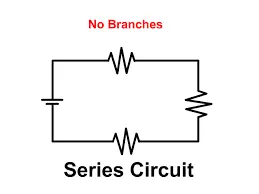To calculate the voltage drop in series circuit, you need to follow these steps:
- Determine the total resistance of the circuit by adding up the individual resistance values of each component.
- Measure the current flowing through the circuit using an ammeter.
- Multiply the current by the total resistance to find the total voltage of the circuit.
- Measure the voltage at each component in the circuit using a voltmeter.
- Subtract the voltage of each component from the total voltage to find the voltage drop across each component.
For example, let’s say you have a series circuit with three resistors: R1= 100 ohms, R2= 200 ohms, and R3= 300 ohms. The total resistance of the circuit would be Rtotal= R1 + R2 + R3 = 100 + 200 + 300 = 600 ohms.

If you measure the current flowing through the circuit and find it to be I = 0.5 amps, then the total voltage of the circuit would be Vtotal = I x Rtotal = 0.5 x 600 = 300 volts.

Next, measure the voltage at each resistor using a voltmeter. Let’s say you measure the voltage at R1 to be V1= 50 volts, at R2 to be V2= 100 volts, and at R3 to be V3= 150 volts.
To find the voltage drop across each resistor, subtract the voltage of each resistor from the total voltage:
- The voltage drop across R1 would be Vdrop1 = Vtotal – V1 = 300 – 50 = 250 volts
- The voltage drop across R2 would be Vdrop2 = Vtotal – V2 = 300 – 100 = 200 volts
- The voltage drop across R3 would be Vdrop3 = Vtotal – V3 = 300 – 150 = 150 volts
Therefore, the voltage drop across each resistor in the circuit is 250 volts, 200 volts, and 150 volts, respectively.
Read Also: Use of Voltage Divider
Application of Ohm’s Law
Ohm’s Law describes the relationship between voltage (V), current (I), and resistance (R) in a circuit, stating that V = IR. It is used to design and analyze circuits and to select components like resistors.
Ohm’s Law
To calculate voltage drop in a series circuit using Ohm’s Law, you need to know the resistance of the circuit (R) and the current flowing through the circuit (I).

In a series circuit, the total resistance (RT) is equal to the sum of the individual resistances in the circuit. So, if you have n resistors in series, the total resistance can be calculated using the formula:
RT = R1 + R2 + R3 + … + Rn
Once you know the total resistance, you can use Ohm’s Law (V = IR) to calculate the voltage drop (VD) across each resistor. The voltage drop across a specific resistor is proportional to its resistance, so the voltage drop across each resistor can be calculated using the formula:
VD = IRn
where n is the number of the resistor you are interested in.
For example, let’s say you have a series circuit with three resistors: R1 = 10 ohms, R2 = 20 ohms, and R3 = 30 ohms. The total resistance of the circuit would be:
RT = R1 + R2 + R3 = 10 + 20 + 30 = 60 ohms
If the current flowing through the circuit is 2 amps, you can calculate the voltage drop across each resistor using Ohm’s Law:
VD1 = IR1 = 2 x 10 = 20 volts VD2 = IR2 = 2 x 20 = 40 volts VD3 = IR3 = 2 x 30 = 60 volts
So the voltage drop across R1 is 20 volts, across R2 is 40 volts, and across R3 is 60 volts.
